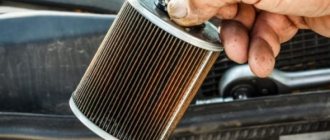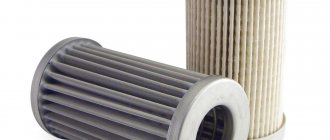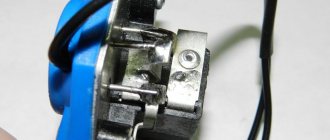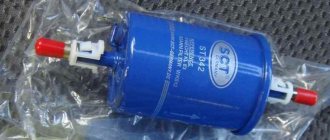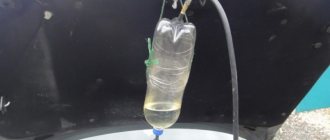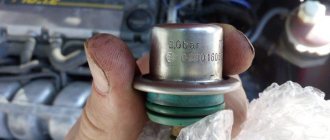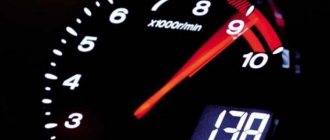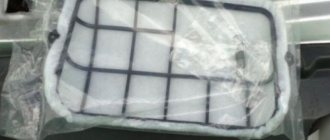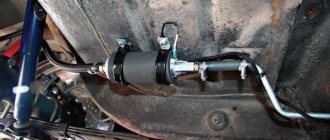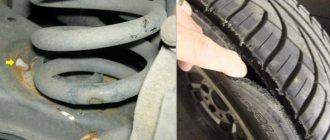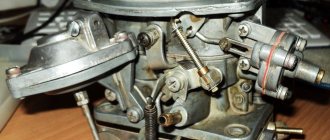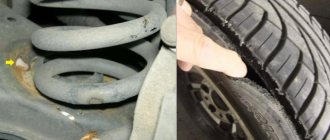The smooth operation of a vehicle largely depends on the quality of the fuel used.
Any fuel contains impurities to a greater or lesser extent that negatively affect engine performance.
Therefore, it must undergo unconditional multi-stage cleaning.
- 2 Types of fuel filters
- 3 Purpose of fuel filters
- 4 Coarse filters
4.1 Design and principle of operation of the coarse settling filter
- 5.1 Types of fine filters
- 7.1 Cleaning the fuel filter
- 10.1 Video: replacing the fuel filter
Fuel filter device
The fuel filter is responsible for removing impurities from the fuel supplied to the engine cylinders.
It usually comes in the form of a filter paper cartridge.
The basis of the fuel filter is usually a cartridge with filter paper
The fuel filter cannot be restored or repaired, but is replaced at certain intervals.
The filter housing with inlet and outlet fittings is made of heat-resistant material.
High-quality ten-micron paper is used as filter material.
The fuel filter design is quite simple.
Modern cars usually have two fuel filters:
- Coarse filter (FGO), which retains impurity particles larger than 0.1 mm.
- Fine filter (FFO) that retains particles smaller than 0.1 mm.
Two-stage cleaning provides reliable protection of the engine from the ingress of fuel with impurities into it.
Rules for installing filtration devices
When using a multi-stage cleaning device, the first stage is always a filter that performs rough cleaning. When using several types of systems, first install a device with high micropressure.
If you install filters of different cleaning methods in the wrong sequence, they will not be able to fully perform the task.
It is not recommended to install filter devices in front of pumping equipment. The exception is strainers with approximately zero resistance, which protect the pump from large debris.
The use of any other filters - iron removers, softeners, etc. - will increase the load on the pumping station and cause its premature wear. Installation, adjustment and repair are carried out in the absence of pressure in the water supply.
Purpose of fuel filters
Modern cars are extremely sensitive to fuel quality. The fuel sold at gas stations already contains foreign impurities.
In addition, water, rust from the walls of steel tanks, dust and dirt from the refueling nozzle get into gasoline or diesel fuel.
Modern cars are sensitive to fuel quality
In injection systems, mechanical impurities in the fuel can cause premature wear and, as a result, failure of the injectors and fuel pump.
The filter removes condensation and contaminants before fuel enters the system, thereby preventing unpleasant consequences.
Moreover, the combustion efficiency of purified fuel is noticeably higher. As a result, engine power increases.
As a result of untimely replacement or failure of the fuel filter:
- there are problems starting the engine;
- blockages form in the fuel lines;
- individual elements of the injection system wear out;
- the carburetor becomes clogged;
- fuel consumption increases.
What is the danger of dirt?
In carburetor-type engines, the ejector principle comes into force, when air at high speed pulls fuel with it at low speed. That is why, when developing jets, strict adherence to patterns and clearances is important. A discrepancy of a hundredth of a millimeter can have negative consequences on the operation of the system as a whole. In particular, the volume of air entering the system changes, power drops, throttle response decreases, and so on.
We must not forget about another potential problem - clogging of the injector (nozzle). It is no secret that in engines running on diesel fuel and gasoline, the fuel mixture and air are mixed directly in the engine. First, pressure is created, thanks to which the fuel mixture flows to the power unit.
For example, in gasoline engines the supply pressure is 10-20, and in diesel engines 100-200 atmospheres. In this case, the volume of fuel supply is regulated by the controller. As soon as the control body sends the appropriate signal, the injector valve opens, followed by spraying of the combustible mixture into the combustion chamber.
Diesel engines (usually older versions) used a slightly different principle for supplying the fuel mixture. In particular, the main operating “person” was a plunger pump that creates the necessary pressure. As for the volume of incoming fuel, the plunger mechanism takes on this work.
But that's not all. Contaminated fuel can cause problems for the cylinder head by clogging the spaces between the seat and the valve. As a result, a cavity forms and compression decreases. At the same time, almost all characteristics of the power unit deteriorate - power, resource, “gluttony” and so on.
Coarse filters
FGOs trap only large particles of impurities in fuel. They are usually made in the form of a metal (brass) mesh, which can be removed, washed and returned to its place.
In carburetor systems, several coarse meshes with cells of different sizes are used.
- A mesh with large cells is installed on the neck of the gas tank.
- A mesh with smaller cells is installed on the fuel intake.
- The inlet fitting is equipped with a mesh with the smallest cells.
Coarse filters are made of brass mesh
In the case of an injection engine, the FGO with a mesh is built into the fuel pump of the gas tank.
Diesel units are usually equipped with a sediment filter. This, however, does not exclude the use of grids.
The diesel fuel coarse filter has a number of advantages over screens, reliably protecting the engine from condensate drops getting into it.
Diesel FGO is not disposable. It can be washed and reinstalled.
Design and principle of operation of the coarse settling filter
The settling filter consists of the following elements:
- housing with lid;
- a filter element made of aluminum plates 0.15 mm thick with protrusions of 0.05 mm - located on a sleeve in a glass attached to the body;
- threaded bushing screwed into the body;
- distributor pressed by bushing;
- sealing paronite gasket between the glass and the body;
- damper located in the lower part of the body.
Diesel engines are usually equipped with a sediment filter
The settling filter works according to the following scheme:
- Through holes in the distributor, diesel fuel enters the filter.
- The fuel moves lower into the damper - large particles of mechanical impurities and condensate remain here.
- Then the fuel goes up to the mesh of the filter part, on which small particles of impurities remain.
- Fuel enters the engine through the fuel outlet.
Model overview
Honeywell F76S ½ is a mainline model from a famous German brand. A mechanism for self-washing is provided. The device is equipped with a thin mesh filter. The manufacturer provides a one-year warranty for continuous use.
Unfortunately, there are often fakes on sale, the quality of which causes criticism. When purchasing, you need to make sure that you have documents with the manufacturer’s details.
Titan A380 is supplied to the market by a domestic manufacturer. A two-stage device with preliminary mechanical purification, equipped with polyfiber membranes and sorption elements. Installation of permanent flushing is possible. The product comes with a three-year warranty.
Detains all impurities, including iron. The manufacturer provides the possibility of washing the elements. For heavily polluted water, it is recommended to install a mechanical coarse filter after it.
"Cascade-duo" is an inexpensive domestic filter with two flasks. Performs mechanical and sorption cleaning. The main filter element is MAS mineral filler. Cartridges are changed once a year. Price from 4,000 rubles.
Vieir ½ is designed for fine purification of hot water. The device has a built-in pressure reducer. The brass body can withstand loads well.
Sources: sovet-ingenera.com; o-vode.net; econet.ru
Fine filters
The main purpose of the FTO is to clean fuel from small foreign particles that were not caught by the coarse filter.
Its design is practically no different from the FGO, and the mesh consists of smaller cells.
Types of fine filters
There are non-separable (disposable) and collapsible (reusable) fine filters.
The former are made of fabric or paper that is folded into a spiral or star shape to form a filter curtain.
The spiral shape provides better cleaning due to the increased surface of the filter material by 1.8 times - the contact of the fuel with the filter becomes longer.
Non-removable filters last quite a long time
Non-removable filters are usually installed on the fuel line section in front of the fuel pump.
There is no pressure in this place, and the likelihood of leakage is reduced.
The basis of the dismountable FTO device is a brass or ceramic mesh filter element.
These filters can be removed, washed and cleaned.
The most convenient are filters with a transparent body, as they allow you to visually assess the degree of contamination of the filter material.
The transparent housing allows you to visually assess the degree of filter contamination
Description of devices
A device for fine filtration of water consists of a housing made of stainless metals or plastic, often transparent, and an element for filtering incoming water, which is used as:
- Sorption materials (aluminosilicate, activated carbon).
- Reverse osmosis membranes.
- Ion exchange resins.
- Polypropylene, polyester.
Each device has two inlet holes - for supplying water and an outlet - for taking purified water. When passing through the filter, water is purified from heavy metals, chemical compounds, organic impurities, microorganisms and is supplied for further use. The filter elements of the device must be replaced regularly, the frequency of which is indicated by the manufacturer.
Fuel filter location
The location of the FTO depends on the type of transport and the characteristics of its fuel system.
In any case, it will definitely be located between the gas tank and the engine.
The FTO can be located under the bottom or under the hood of the car. There are options for installing it in the gas tank together with a coarse filter and a fuel pump.
Cleaning of large contaminants must occur before fuel enters the fuel system.
Therefore, the FGO is most often located in the gas tank. Sometimes it can be located under the bottom of the car in the engine compartment.
In this case, the fine filter will be installed between the carburetor and the fuel pump.
The installation location of fuel filters depends on the fuel supply system.
- In carburetor systems, coarse fuel cleaning is carried out in the gas tank. In this case, the FTO is located directly in front of the carburetor. It is usually built into the fuel supply line to the fuel pump. It is easy to recognize by its transparent body.
- In injection engines, the FGO is located under the bottom of the vehicle, and the FGO is usually located in or near the gas tank. If it is not near the tank, and the fuel line comes from the tank under the hood, then the filter is definitely located in the gas tank.
- In diesel engines, the fuel filter has impressive dimensions. It is installed between the engine and the fuel pump. You can find it through the fuel lines - the pump inlet pipe is always directed away from the filter. The location of the FGO depends on the car model, and the fine filter is always installed near the injection pump and injectors.
You can find the fuel filter by looking at the fuel lines
Mesh filters are always installed in standard places, and they are quite easy to find.
In any case, the sediment filter will be located near the gas tank. It can be easily found by the pipes coming from the tank.
Procedure for replacing the fuel filter
Timely replacement or cleaning of fuel filters is necessary for all types of engines.
- In the case of a gasoline carburetor engine, the need to clean the fuel is dictated by the fact that the fuel channels in the carburetor are often clogged due to low-quality fuel. Moreover, individual carburetor elements may be damaged or destroyed due to the abrasive properties of impurities.
- Injection systems are even more demanding on the quality of fuel, since it is supplied to the cylinders in small doses under high pressure. Fuel is supplied using injectors consisting of high-precision elements (precision pairs). Mechanical impurities in the fuel can damage the surface of these elements, and the injector will fail.
- Diesel units place even higher demands on fuel purification. Here, precision pairs are installed not only in the injectors, but also in the pump, which can also fail.
Manufacturers claim that the diesel fuel purifier or its filter part needs to be changed at least once every 30 thousand km.
The fuel filter completely loses its original properties after 30,000 km.
The frequency of replacing the fuel filter is determined by:
- car model;
- operating conditions;
- the quality of the filter itself.
All fuel filters can be divided into two groups:
- submersible, located in the housing of the pump immersed in the gas tank,
- main, located on the fuel line between the tank and the power unit.
By type of fastener there are:
- fuel filters that can be removed by hand;
- filters installed by the manufacturer on specific fasteners (to dismantle you have to buy a special tool or contact a service station);
- filters replaceable using a standard set of tools.
To replace the fuel filter yourself, you will need the following tools:
- standard set of wrenches;
- screwdrivers;
- protective gloves;
- container for draining fuel from the filter;
- pump or compressor.
The fuel filter is replaced in accordance with the following algorithm.
- The non-separable FTO on a carburetor engine is secured with clamps in the fuel line. To replace it, loosen the clamps, replace the filter with a new one and secure it.
- In the case of injection systems, access to the FGO (and sometimes to the FTO) is possible through a hatch in the tank. The fine filter, located outside the tank, is changed after loosening the gas line clamps. To do this you should:
- remove the rear seat;
- open the hatch;
- remove the fastening nut;
- disconnect the hoses;
- remove the fuel pump power connector;
- disassemble the fuel system housing.
- The most difficult thing to replace is fuel filters on a diesel engine. If a sediment filter is built-in, it is first disconnected from the power system. Then it is disassembled using wrenches, and the fuel is poured into a previously prepared container. The filter is washed and blown with compressed air, and the filter material (if any) is replaced with a new one.
The collapsible FTO is changed in the same way as the filter element of the coarse filter, and the non-separable filter is removed and replaced with a new one.
Most often, it is impossible to visually assess whether a filter needs to be replaced - usually the filter elements are not visible.
The exception is some models for carburetor engines.
The main symptoms of a dirty fuel filter are as follows.
- The engine stalls periodically.
- The engine stalls when the speed decreases.
- The car has a hard time picking up speed, especially on an incline.
- The engine is difficult to start in the morning.
- Fuel consumption increases.
- The motor power gradually decreases.
- When you press the accelerator pedal, the car moves jerkily.
After replacing the filter, you should once again check the reliability of all connections and tighten if necessary.
There should be no leaks or holes where the filters connect to the fuel lines.
Cleaning the fuel filter
Cleaning is possible only for dismountable types of fuel filters. In general, the procedure for washing is as follows.
- The filter is removed and wiped with a dry cloth.
- The cover securing bolts are unscrewed and the cover is removed.
- The filter element is pulled out.
- The inside of the case is wiped with a dry, lint-free cloth.
- The filter and plug are washed with acetone and blown with compressed air.
- A new sealing ring is put on the filter.
- The filter is put in place and connected to the fuel lines.
- Gasoline is poured to the edges of the filter.
- The lid is screwed on.
- The plug closes.
It is necessary to clean or completely replace the fuel purifier in gasoline cars every 60–100 thousand km.
On carburetor engines, coarse filters are serviced as follows.
- The mesh is pulled out of the fuel neck.
- If the mesh is clogged with dirt, it is washed in gasoline and blown with a stream of compressed air.
- The fuel intake comes from the gas tank.
- The mesh removed from the fuel intake is cleaned in the same way as the mesh from the fuel neck.
- The carburetor inlet fitting is unscrewed.
- The mesh from the carburetor inlet fitting is washed and blown.
After cleaning and installing the filters in place, you should start the engine and let it idle for about a minute.
After this, it is necessary to inspect the filter connections for fuel leaks.
Why does fuel get dirty?
The operation of the internal combustion engine depends on the quality of the incoming fuel. The poorer the quality of the fuel, the more various impurities it contains. To clean the fuel from impurities, a fine fuel filter is used. The article highlights why you need to change it and describes in detail how the replacement is performed.
Content
[ To uncover]
[Hide]
Why do you need to change the fine filter?
Any car that uses various working fluids is equipped with special elements that serve to cleanse the fluids from harmful impurities. The fuel system uses a coarse and fine filter to clean the fuel. During the operation of the car, it becomes clogged and does not perform its functions efficiently. Therefore, it has to be changed periodically.
BIG fuel filter
Gasoline contains abrasive particles that negatively affect the operation of the internal combustion engine. There are special meshes on the gas tank, carburetor and fuel pump for cleaning fuel, but they are not enough for high-quality purification of gasoline. They can only trap large particles.
Fine filters are designed to capture small particles. They can trap elements as small as 15 microns.
If you do not change the filter element in time, this can lead to the following problems when operating the car:
- The engine runs jerkily, first at high speeds, and then when switching to low speeds.
- The car loses power. A contaminated element does not perform its functions, as a result, the fuel injection nozzles become clogged and the fuel system becomes clogged. Thus, an insufficient amount of gasoline enters the engine, which leads to a decrease in its power.
- Premature wear of lambda probes, spark plugs and accelerators. If cleaning is poor, the fuel does not burn out completely; some of it settles on the cylinder walls, spark plugs and pistons. As a result, the fuel mixture is saturated with heavy metals and foreign particles, and then enters the exhaust gas system through accelerators and lambda probes, which significantly reduces the service life of parts.
- Fuel consumption increases. A clogged fuel filter does not directly affect fuel consumption, but it does cause a decrease in vehicle power. As a result, to accelerate the car to the desired speed, you have to put more pressure on the gas, which requires more fuel consumption.
- The car won't start. If you neglect to change the filter element, as required by the manufacturer, the engine may not start.
Filters differ in design and are divided into non-separable and collapsible products. Non-separable ones refer to disposable parts.
Non-separable fuel filter
The collapsible one consists of a ceramic element and a mesh that can be cleaned, washed and used several times. The cost of a dismountable filter is slightly higher than a disposable one.
Where is?
If the procedure for replacing the fuel filter is the same on almost all car models, then the location where it is located differs. Most often it is located in the upper part of the car's engine compartment, and it is also often placed in the tank next to the gas pump.
Depending on where the filter element is located, to carry out replacement the machine is either driven onto a lifting device or placed in a convenient position to ensure access to the part.
The process of replacing the fine filter
The conclusion that the filter needs to be changed can be made from a visual inspection. But there are signs by which you can determine that it is clogged: frequent jerking at high and low speeds.
If, after inspecting the filter element, it turns out that it is clogged, then there are two options for solving this problem:
- try to clean the element from contamination;
- replace with a new product.
You should not wait for the contaminated element to manifest itself.
Manufacturers recommend changing the filter element after 10,000 -15,000 kilometers. If the car is used in difficult conditions, low-quality gasoline is poured in, the replacement should be performed more often - after 7-8 thousand km.
The first obstacle to suspended particles in the fuel is the filter element in the fuel tank of the car. As a rule, it is a frame sealed in a mesh, which is a barrier to solid particles. This type of cleaning cannot prevent small particles, water, paraffins and resins from entering the fuel equipment.
But thanks to it, most of the large elements - corrosion products and debris - are eliminated. They are present in any fuel tank. This prevents clogging of low-pressure lines, and also significantly increases the service life of the coarse filter.
In most cases, replacing this element is not regulated by the manufacturer, but it is recommended. Its service life directly depends on the newness of the car, its technical condition and fuel quality. The mesh element in the car tank is the cheapest link in the entire chain of fuel supply to the engine, but no less important, so you should not neglect checking it and, if necessary, replacing it.
The second stage is carried out by “coarse” fuel filters (sediment filters). Their name is due to the presence of a settling glass. In the lower part it is equipped with a damper, thanks to which it is possible to remove water.
DETAILS: Replacing the cabin filter Nissan X-Trail Photo instructions on how to change the cabin filter X-Trail T31
And in its upper part there is a mesh or plate filter element, which allows you to get rid of particles up to 0.05 mm in size remaining after the first stage. Next, the fuel enters the low pressure fuel pump (LPFP).
This type of filter has a drain plug to clean the glass from condensation and sediment. Most sediment filters have a collapsible design. This design of the diesel engine fuel filter makes it possible to wash and, if necessary, replace the filter element and thereby restore cleaning efficiency.
A special type of filter at this stage are heated separators for diesel fuel. Their price is significantly higher than that of conventional settling filters, but the quality of fuel purification is more effective, and heating solves the problem of paraffins. They are capable of removing up to 95% of water and impurities from diesel fuel.
The cleaning process begins with the fuel heating stage, which prevents the crystallization of paraffins and water. Then, under the influence of centrifugal forces that arise when the emulsion swirls and passes through special channels, water and impurities are separated and deposited in the settling glass.
To separate smaller particles, the principle of changing the direction of flow is used, which is implemented using separator blades. The final stage is a corrugated cartridge that removes the smallest solid particles.
Often there are “coarse” filters connected to a booster pump or a “fine” filter.
In most cases, contamination of “coarse” filters will not be noticeable during vehicle operation, because The performance of the injection pump is always higher than necessary for stable engine operation. Therefore, in order to prevent costly repairs, it is necessary to promptly remove accumulated water and debris from the sump and not ignore the need to replace the filter element.
It is recommended to check the presence of sludge and condensate daily. During the cold season, it is better to do such a check after each trip. The service life of the filter element does not exceed 15-30 thousand km.
The final barrier for fuel before it enters the diesel engine is a fine filter. It allows you to get rid of the solid particles remaining in the previous stages that are not visible to the eye, as well as the formed resins. Another of its functions is to protect the engine from air that gets into the fuel during the early stages of cleaning.
Through the jet valve, air with excess fuel is discharged back into the tank. The temperature difference between the exhaust mixture and the fuel in the tank contributes to the formation of condensation and an increase in water content. The “fine” cleaning function at this stage is performed by a replaceable element consisting of special porous paper.
When pouring fuel into the tank, car enthusiasts do not even think about the possible risk of contamination of the combustible mixture. It is believed that oil refineries have completed the full purification cycle and delivered already purified fuel to gas stations. In principle, this is how it is.
But we must not forget that fuel is delivered by rail in tanks or by sea in tankers, and is distilled using special tubes and hoses. As a result, the fuel accumulates harmful substances, most of which clog the internal systems of the car.
Hazardous elements do not disappear anywhere - they accumulate in transportation containers (tanks, tanks). In the process of filling a new batch of fuel, the active mixture rises from the bottom and mixes with the once pure gasoline or diesel fuel. Next, the fuel goes to the car tanks and to the engine.
Features of diesel fuel filters
The main task of diesel fuel purification is to prevent condensation from entering the engine.
In most cases, water is separated from the fuel by a separator filter.
The diesel fuel filter must heat the fuel and protect the engine from condensation.
In addition, the properties of diesel fuel change with decreasing temperature.
Therefore, the filter must be adapted to the cold. This problem is solved by adding a heating system to the filter (for example, a curtain can be paper, capable of conducting current).
This way, the optimal temperature of the mixture of cold fuel from the tank and heated fuel from the filter is maintained.
Some models of fuel filters for diesel engines have a system for separating condensate and sensors that indicate the water content in the fuel.
Quality criteria for fuel filters
Cheap, low-quality fuel filters are not able to protect engine parts that come into contact with fuel from premature wear and rust.
The reasons for this are as follows:
- the filter material may tear during operation;
- such filters quickly become clogged and do not allow fuel to pass through;
- cheap filters have low absorption capacity;
- poor-quality filter material will not be able to retain small particles of impurities.
The filter element of a high-quality filter will not tear, and impurities in the fuel will not damage the injectors.
Features of work
Such filters require regular replacement of working elements (membranes or cartridges). The operation of the device is based on the properties of various filter materials. Most often manufacturers use:
- sorbents;
- reverse osmosis type membranes;
- ion exchange resins.
The frequency of replacement of filter elements is strictly specified in the instructions included with the product. It is determined by two factors: service life and productivity (amount of filtered water).
